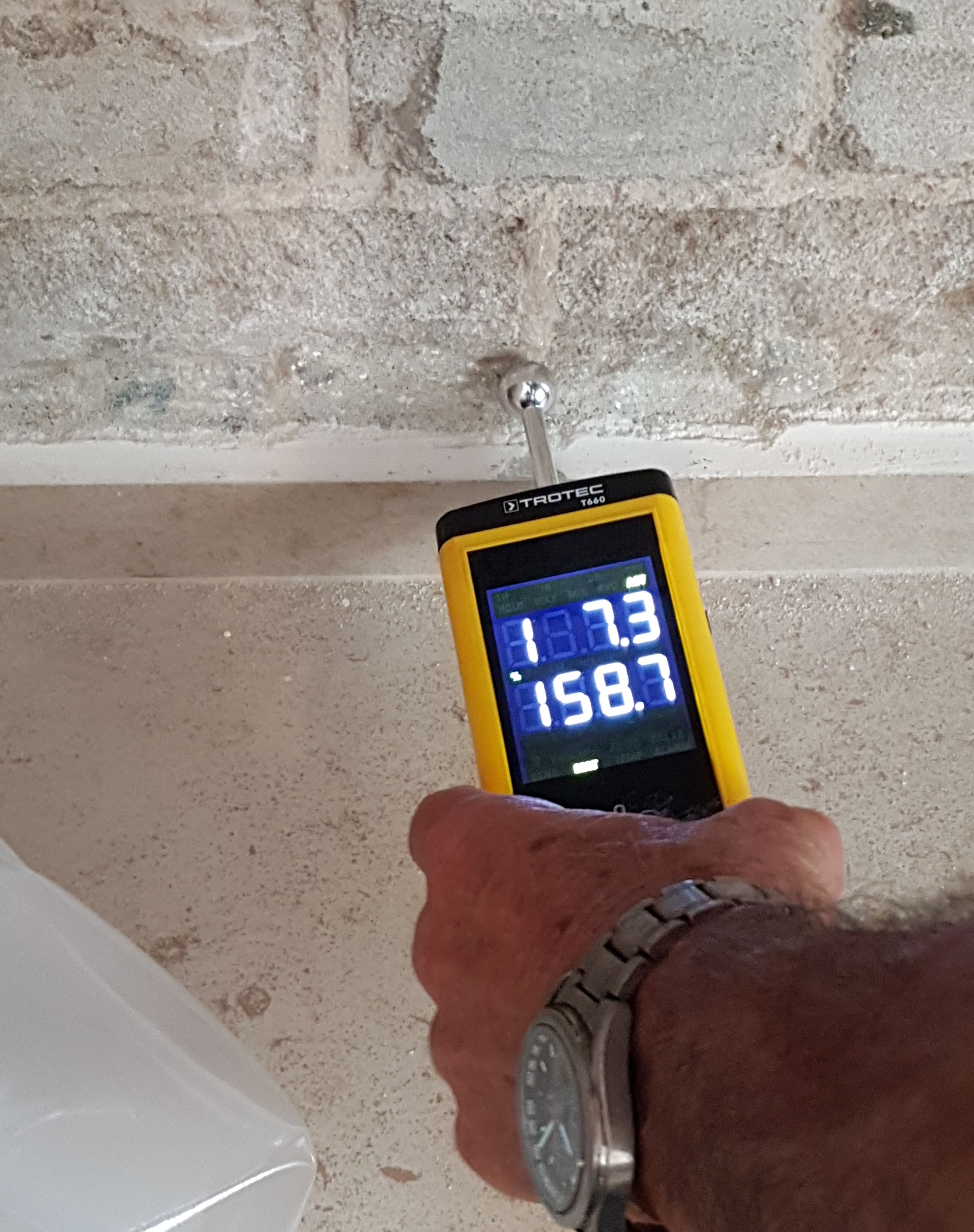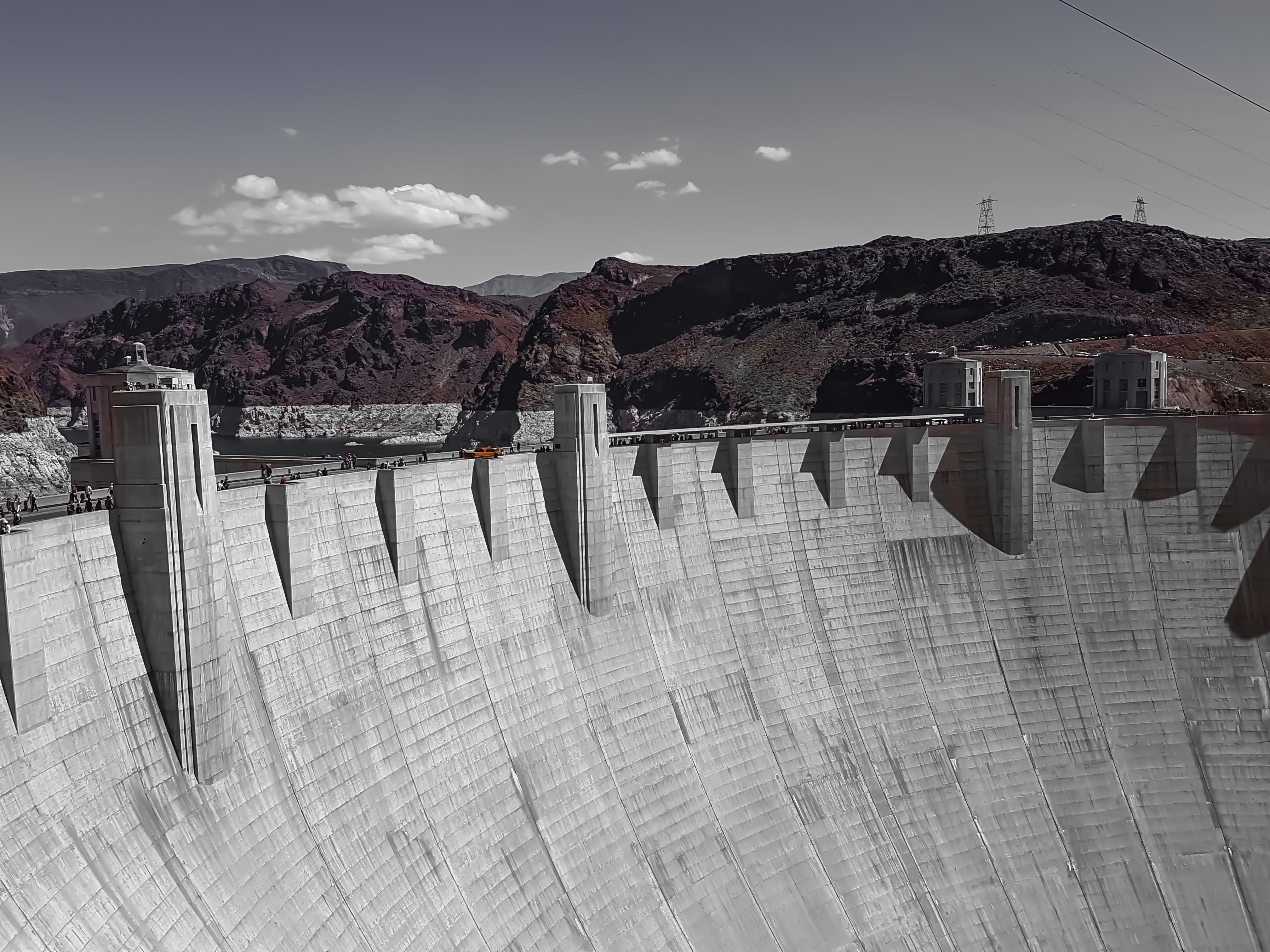|
Concrete Moisture Meter
A concrete moisture meter is a type of moisture meter used by installers of flooring to measure the moisture levels of concrete. These meters have been used for decades to measure the moisture content in different materials and substances. Concrete meters have evolved from the successful wood moisture meter as flooring contractors tried to use their wood meters to measure the moisture in concrete. Concrete moisture meters are designed to detect moisture to a depth of 1” of a concrete slab in order to avoid the rebar reinforcement below the surface. They are designed to be used as a relative test. The meters are used to “‘Spot check’ the top surface at one particular location on the slab.” The results can determine the best place to put a concrete relative humidity test. Limitations There is no ASTM standard for using a concrete moisture meter to determine a final moisture content reading. Concrete moisture meters, either non-pin or pin meters are affected by what ... [...More Info...] [...Related Items...] OR: [Wikipedia] [Google] [Baidu] |
Moisture Meter
Moisture meters are used to measure the percentage of water in a given substance. This information can be used to determine if the material is ready for use, unexpectedly wet or dry, or otherwise in need of further inspection. Wood and paper products are very sensitive to their moisture content. Physical properties are strongly affected by moisture content and high moisture content for a period of time may progressively degrade a material. Meters for wood Newly-cut logs can have a moisture content (MC) of 80% or more, depending on species. Since wood shrinks, and can also split, twist or otherwise change shape as it dries, most wood is dried before being used. This is most often done using a kiln A kiln is a thermally insulated chamber, a type of oven, that produces temperatures sufficient to complete some process, such as hardening, drying, or chemical changes. Kilns have been used for millennia to turn objects made from clay int ..., but may use the air drying method, ... [...More Info...] [...Related Items...] OR: [Wikipedia] [Google] [Baidu] |
Flooring
Flooring is the general term for a permanent covering of a floor, or for the work of installing such a floor covering. Floor covering is a term to generically describe any finish material applied over a floor structure to provide a walking surface. Both terms are used interchangeably but floor covering refers more to loose-laid materials. Materials almost always classified as flooring include carpet, laminate, tile, and vinyl. Subfloor The floor under the flooring is called the subfloor, which provides the support for the flooring. Special purpose subfloors like floating floors, raised floors or sprung floors may be laid upon another underlying subfloor which provides the structural strength. Subfloors that are below grade (underground) or ground level floors in buildings without basements typically have a concrete subfloor. Subfloors above grade (above ground) typically have a plywood subfloor. Flooring materials The choice of materials for floor covering is affected by ... [...More Info...] [...Related Items...] OR: [Wikipedia] [Google] [Baidu] |
Concrete
Concrete is a composite material composed of fine and coarse aggregate bonded together with a fluid cement (cement paste) that hardens (cures) over time. Concrete is the second-most-used substance in the world after water, and is the most widely used building material. Its usage worldwide, ton for ton, is twice that of steel, wood, plastics, and aluminum combined. Globally, the ready-mix concrete industry, the largest segment of the concrete market, is projected to exceed $600 billion in revenue by 2025. This widespread use results in a number of environmental impacts. Most notably, the production process for cement produces large volumes of greenhouse gas emissions, leading to net 8% of global emissions. Other environmental concerns include widespread illegal sand mining, impacts on the surrounding environment such as increased surface runoff or urban heat island effect, and potential public health implications from toxic ingredients. Significant research and developmen ... [...More Info...] [...Related Items...] OR: [Wikipedia] [Google] [Baidu] |
Moisture Content
Water content or moisture content is the quantity of water contained in a material, such as soil (called soil moisture), rock, ceramics, crops, or wood. Water content is used in a wide range of scientific and technical areas, and is expressed as a ratio, which can range from 0 (completely dry) to the value of the materials' porosity at saturation. It can be given on a volumetric or mass (gravimetric) basis. Definitions Volumetric water content, θ, is defined mathematically as: :\theta = \frac where V_w is the volume of water and V_\text = V_s + V_w + V_a is equal to the total volume of the wet material, i.e. of the sum of the volume of solid host material (e.g., soil particles, vegetation tissue) V_s, of water V_w, and of air V_a. Gravimetric water content is expressed by mass (weight) as follows: :u = \frac where m_w is the mass of water and m_s is the mass of the solids. For materials that change in volume with water content, such as coal, the gravimetric water content, ''u ... [...More Info...] [...Related Items...] OR: [Wikipedia] [Google] [Baidu] |
Concrete Slab
A concrete slab is a common structural element of modern buildings, consisting of a flat, horizontal surface made of cast concrete. Steel-Reinforced concrete, reinforced slabs, typically between 100 and 500 mm thick, are most often used to construct floors and ceilings, while thinner ''mud slabs'' may be used for exterior paving . In many domestic and industrial buildings, a thick concrete slab supported on Foundation (engineering), foundations or directly on the subsoil, is used to construct the ground floor. These slabs are generally classified as ''ground-bearing'' or ''suspended''. A slab is ground-bearing if it rests directly on the foundation, otherwise the slab is suspended. For multi-story buildings, there are several common slab designs : * Beam and block, also referred to as ''rib and block'', is mostly used in residential and industrial applications. This slab type is made up of pre-stressed beams and hollow blocks and are temporarily propped until set, typicall ... [...More Info...] [...Related Items...] OR: [Wikipedia] [Google] [Baidu] |
Rebar
Rebar (short for reinforcing bar), known when massed as reinforcing steel or reinforcement steel, is a steel bar used as a tension device in reinforced concrete and reinforced masonry structures to strengthen and aid the concrete under tension. Concrete is strong under compression, but has weak tensile strength. Rebar significantly increases the tensile strength of the structure. Rebar's surface features a continuous series of ribs, lugs or indentations to promote a better bond with the concrete and reduce the risk of slippage. The most common type of rebar is carbon steel, typically consisting of hot-rolled round bars with deformation patterns embossed into its surface. Steel and concrete have similar coefficients of thermal expansion, so a concrete structural member reinforced with steel will experience minimal differential stress as the temperature changes. Other readily available types of rebar are manufactured of stainless steel, and composite bars made of glass fiber, car ... [...More Info...] [...Related Items...] OR: [Wikipedia] [Google] [Baidu] |
Relative Humidity
Humidity is the concentration of water vapor present in the air. Water vapor, the gaseous state of water, is generally invisible to the human eye. Humidity indicates the likelihood for precipitation, dew, or fog to be present. Humidity depends on the temperature and pressure of the system of interest. The same amount of water vapor results in higher relative humidity in cool air than warm air. A related parameter is the dew point. The amount of water vapor needed to achieve saturation increases as the temperature increases. As the temperature of a parcel of air decreases it will eventually reach the saturation point without adding or losing water mass. The amount of water vapor contained within a parcel of air can vary significantly. For example, a parcel of air near saturation may contain 28 g of water per cubic metre of air at , but only 8 g of water per cubic metre of air at . Three primary measurements of humidity are widely employed: absolute, relative, and specific. A ... [...More Info...] [...Related Items...] OR: [Wikipedia] [Google] [Baidu] |
Concrete Moisture Meter
A concrete moisture meter is a type of moisture meter used by installers of flooring to measure the moisture levels of concrete. These meters have been used for decades to measure the moisture content in different materials and substances. Concrete meters have evolved from the successful wood moisture meter as flooring contractors tried to use their wood meters to measure the moisture in concrete. Concrete moisture meters are designed to detect moisture to a depth of 1” of a concrete slab in order to avoid the rebar reinforcement below the surface. They are designed to be used as a relative test. The meters are used to “‘Spot check’ the top surface at one particular location on the slab.” The results can determine the best place to put a concrete relative humidity test. Limitations There is no ASTM standard for using a concrete moisture meter to determine a final moisture content reading. Concrete moisture meters, either non-pin or pin meters are affected by what ... [...More Info...] [...Related Items...] OR: [Wikipedia] [Google] [Baidu] |
ASTM
ASTM International, formerly known as American Society for Testing and Materials, is an international standards organization that develops and publishes voluntary consensus technical standards for a wide range of materials, products, systems, and services. Some 12,575 ASTM voluntary consensus standards operate globally. The organization's headquarters is in West Conshohocken, Pennsylvania, about northwest of Philadelphia. It is founded in 1902 as the American Section of the International Association for Testing Materials (see also International Organization for Standardization). History A group of scientists and engineers, led by Charles Dudley, formed ASTM in 1898 to address the frequent rail breaks affecting the fast-growing railroad industry. The group developed a standard for the steel used to fabricate rails. Originally called the "American Society for Testing Materials" in 1902, it became the "American Society for Testing And Materials" in 1961. In 2001, ASTM off ... [...More Info...] [...Related Items...] OR: [Wikipedia] [Google] [Baidu] |
Density
Density (volumetric mass density or specific mass) is the substance's mass per unit of volume. The symbol most often used for density is ''ρ'' (the lower case Greek letter rho), although the Latin letter ''D'' can also be used. Mathematically, density is defined as mass divided by volume: : \rho = \frac where ''ρ'' is the density, ''m'' is the mass, and ''V'' is the volume. In some cases (for instance, in the United States oil and gas industry), density is loosely defined as its weight per unit volume, although this is scientifically inaccurate – this quantity is more specifically called specific weight. For a pure substance the density has the same numerical value as its mass concentration. Different materials usually have different densities, and density may be relevant to buoyancy, purity and packaging. Osmium and iridium are the densest known elements at standard conditions for temperature and pressure. To simplify comparisons of density across different syst ... [...More Info...] [...Related Items...] OR: [Wikipedia] [Google] [Baidu] |
Construction
Construction is a general term meaning the art and science of forming Physical object, objects, systems, or organizations."Construction" def. 1.a. 1.b. and 1.c. ''Oxford English Dictionary'' Second Edition on CD-ROM (v. 4.0) Oxford University Press 2009 It comes from the Latin word ''constructio'' (from ''com-'' "together" and ''struere'' "to pile up") and Old French ''construction''. To 'construct' is a verb: the act of building, and the noun is construction: how something is built or the nature of its structure. In its most widely used context, construction covers the processes involved in delivering buildings, infrastructure, industrial facilities, and associated activities through to the end of their life. It typically starts with planning, financing, and design that continues until the asset is built and ready for use. Construction also covers repairs and maintenance work, any works to expand, extend and improve the asset, and its eventual demolition, dismantling or wikt:de ... [...More Info...] [...Related Items...] OR: [Wikipedia] [Google] [Baidu] |
Floor Covering
Flooring is the general term for a permanent covering of a floor, or for the work of installing such a floor covering. Floor covering is a term to generically describe any finish material applied over a floor structure to provide a walking surface. Both terms are used interchangeably but floor covering refers more to loose-laid materials. Materials almost always classified as flooring include carpet, laminate, tile, and vinyl. Subfloor The floor under the flooring is called the subfloor, which provides the support for the flooring. Special purpose subfloors like floating floors, raised floors or sprung floors may be laid upon another underlying subfloor which provides the structural strength. Subfloors that are below grade (underground) or ground level floors in buildings without basements typically have a concrete subfloor. Subfloors above grade (above ground) typically have a plywood subfloor. Flooring materials The choice of materials for floor covering is affected by fac ... [...More Info...] [...Related Items...] OR: [Wikipedia] [Google] [Baidu] |







